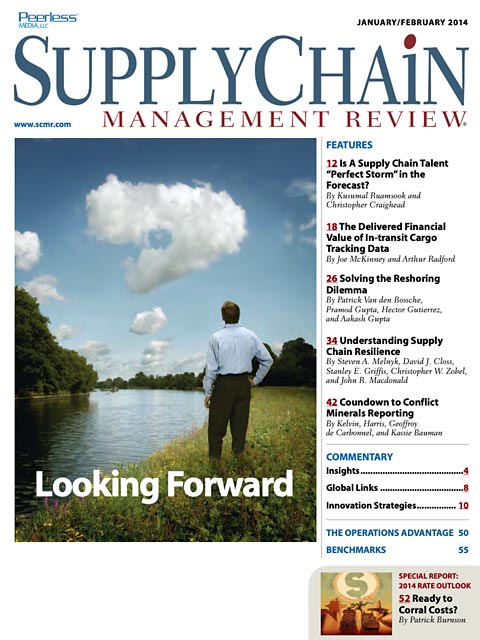Sorry, but your login has failed. Please recheck your login information and resubmit. If your subscription has expired, renew here.
January-February 2014
With the demands for more skilled supply chain professionals, the silver tsunami of retiring workers, and a shortage of supply chain students and instructors, a perfect storm may be brewing. Penn State authors Kusumal Ruamsook and Christopher Craighead outline the factors that may limit the pool of supply chain talent and offer five strategies to help weather the storm. Get this issue to learn more. Browse this issue archive.Need Help? Contact customer service 847-559-7581 More options
When Boeing announced plans to assemble the 787 Dreamliner in late 2003, it introduced a new concept to the assembly of a commercial aircraft. Instead of building the plane from the ground up, subcontractors from around the globe would deliver completed subassemblies to Boeing’s factory in Everett, Wash. for final assembly. While the approach was intended to create a leaner manufacturing process, development of the new aircraft was beset by numerous supply chain related disruptions—events that interrupt the flow of products and information between raw materials, production, and the end customer.
One of those disruptions occurred just last January 2013, when the Dreamliner was grounded by the FAA due to overheating of its new lithium-ion battery. As a result, Boeing needed to slow production of this innovative aircraft until it determined the source of the overheating—a source that appeared to lie within in its supply chain, according to news reports. The question for Boeing was how quickly it could identify the source of the overheating and recover from the disruption.
At bottom, that was a question of how resilient the Dreamliner supply chain was. Boeing is not alone. In today’s increasingly dynamic and turbulent world, one where the supply chain plays an increasingly more important role, numerous events occur each day that threaten to disrupt operations and jeopardize the ability to perform effectively and efficiently. These events include natural and man-made disasters such as equipment failures, fires, labor disputes, supplier defaults, political instability, and terrorist attacks. Each can have devastating effects on a firm. Such disruptions reinforce the insights that not only can supply chain disruptions affect operations; they often result in financial damage well beyond the immediate operational impacts.
 |
This complete article is available to subscribers
only. Click on Log In Now at the top of this article for full access. Or, Start your PLUS+ subscription for instant access. |
Not ready to subscribe, but need this article?
Buy the complete article now. Only $20.00. Instant PDF Download.
Access the complete issue of Supply Chain Management Review magazine featuring
this article including every word, chart and table exactly as it appeared in the magazine.
SC
MR
Sorry, but your login has failed. Please recheck your login information and resubmit. If your subscription has expired, renew here.
January-February 2014
With the demands for more skilled supply chain professionals, the silver tsunami of retiring workers, and a shortage of supply chain students and instructors, a perfect storm may be brewing. Penn State authors Kusumal… Browse this issue archive. Access your online digital edition. Download a PDF file of the January-February 2014 issue.
 |
Download Article PDF |
When Boeing announced plans to assemble the 787 Dreamliner in late 2003, it introduced a new concept to the assembly of a commercial aircraft. Instead of building the plane from the ground up, subcontractors from around the globe would deliver completed subassemblies to Boeing’s factory in Everett, Wash. for final assembly. While the approach was intended to create a leaner manufacturing process, development of the new aircraft was beset by numerous supply chain related disruptions—events that interrupt the flow of products and information between raw materials, production, and the end customer.
One of those disruptions occurred just last January 2013, when the Dreamliner was grounded by the FAA due to overheating of its new lithium-ion battery. As a result, Boeing needed to slow production of this innovative aircraft until it determined the source of the overheating—a source that appeared to lie within in its supply chain, according to news reports. The question for Boeing was how quickly it could identify the source of the overheating and recover from the disruption.
At bottom, that was a question of how resilient the Dreamliner supply chain was. Boeing is not alone. In today’s increasingly dynamic and turbulent world, one where the supply chain plays an increasingly more important role, numerous events occur each day that threaten to disrupt operations and jeopardize the ability to perform effectively and efficiently. These events include natural and man-made disasters such as equipment failures, fires, labor disputes, supplier defaults, political instability, and terrorist attacks. Each can have devastating effects on a firm. Such disruptions reinforce the insights that not only can supply chain disruptions affect operations; they often result in financial damage well beyond the immediate operational impacts.
 |
SUBSCRIBERS: Click here to download PDF of the full article. |
SC
MR

Latest Supply Chain News
Latest Podcast

 Explore
Explore
Latest Supply Chain News
- AdventHealth named top healthcare supply chain by Gartner
- Geopolitical readiness in supply chains: Strategic challenges for leaders
- Unlocking retention: The role employee engagement plays
- Can supply chain managers embrace an entrepreneurial mindset?
- Challenges to ESG reporting
- With capacity to spare, logistics real estate demand remains subdued
- More latest news
Latest Resources

Subscribe

Supply Chain Management Review delivers the best industry content.

Editors’ Picks





